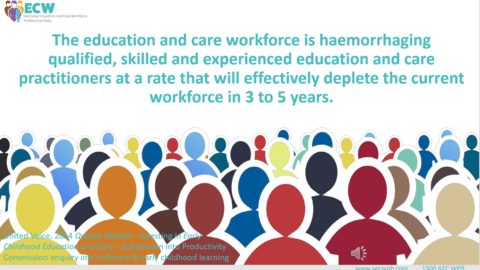Margaret E Sear. ECEfS (Early Childhood Educator for Sustainability)
Addressing Consumerism through a Sustainable lens, the EYLF and the NQS.
“‘Consumerism’ refers to people purchasing goods and consuming materials in excess of their basic needs. In the 21st Century’s globalized economy, ‘consumerism’ has become a noticeable part of the culture and is seen to be what is not environmentally sustainable.” (Wikipedia 1)
Sustainability within Early Childhood Settings can be found in all areas and aspects of our work both administratively and educationally, on a daily basis. It is an area that must be understood and addressed if we are to achieve a higher standard of quality and sustainable practice across the Service.
In considering the effects of ‘consumerism’, it is worth reflecting on its positioning within the National Quality Standards – NQS (2) and its influence throughout the Curriculum, either in the Early Years Learning Framework – EYLF (3) or appropriate ECE document.
Within the NQS it is very easy to focus on Quality Area 3: Physical Environment, when considering your Services’ engagement with ‘consumerism’, and in particular quality standard 3.3: The service takes an active role in caring for its environment and contributes to a sustainable future; element 3.3.1: Sustainable practices are embedded in service operations; and element 3.3.2: Children are supported to become environmentally responsible and show respect for the environment.
This is considered the most obvious Quality Area in which to address ‘consumerism’ as educators and committees/managers carry out their roles, introduce discussion and address the issues of sustainable practice in practical terms such as gardening, recycling, purchasing and waste, energy and water management etc.
Engaging with children, families and management and establishing easily undertaken daily practices and processes to address these issues will lower your reliance on consumables and should make a marked difference to your budget and waste systems long term.
However ‘consumerism; should also be considered in all other quality areas as well.
Quality Area 1 addresses Educational program and practice, and in element 1.1.1: Curriculum decision making etc, and element 1.1.6: Each child’s agency is promoted, etc, there are so many ways that sustainability and ‘consumerism’ can be addressed and have a positive influence on children’s learning as critical thinkers and agents of change. Consider the daily practice of making consumables such as paint, glue, and dough etc. Above and beyond the managerial aspects (Quality Area 7) of sourcing the most cost effective, environmentally friendly and least environmentally damaging products available, when you deliberately consider the impact that engaging with these materials in a sustainable way has on your program and the children that are using them, you will be very intentional in how they are made up and presented to the children, and intentional in the way that children are encouraged to be critical thinkers in their use and disposal.

This applies equally when considering the use of edible products as play materials. We should be stopping to consider the energy and water use, and transportation costs that are required in the manufacture of that product as a food source for human consumption vs. its potential for learning. It is more sustainable to use food products for that purpose alone, such as providing meals and cooking experiences.
Clay has just as many tactile benefits and far more expressive art and creativity benefits than dough, even for toddlers, and is reusable over and over again. This is an important aspect in Education for Sustainable Development (EfSD) and should begin with even the youngest of our children, the babies and toddlers.
Quality Area 2, Children’s Health and Safety, element 2.3.2: Protecting children from harm and hazard etc, addresses this issue through the choices we make in sourcing the best, least harmful products for all areas of our Service from cleaning products, dietary and food choices and in sourcing equipment for play. In our desire to source and utilise recycled and repurposed materials, we must always consider the health and safety aspects of accepting such materials, so too do we also need to consider their environmental impac
When you are sourcing timber offcuts, always seek those that were produced from sustainable timbers and weren’t treated with chemicals for preservation. Your Service should not need to be thought of as a recycling depot for household and industrial consumerism.
Quality Area 4 Staffing Arrangements and Quality Area 5 Relationships with Children both encourage all Service personnel to support each other and the child in seeking the highest quality outcomes possible for life, learning and the Service, and this is attained by encouraging an open, reflective and questioning environment that welcomes and considers all possibilities. These two quality areas are supported through EYLF Principle 5: that encourages “ongoing learning that involves engaging with questions of philosophy, ethics and practice etc”. Reflective practice and considering and implementing change across all aspects of your curriculum and engagement with children and their learning is one of the foundations for sustainable practices.
Quality Area 6 Collaborative partnerships with families and communities, encourages educators and Services to build opportunities to inform and lead when addressing sustainable practice and ‘consumerism’ through open and ongoing conversations about what and why you are doing what you do to achieve the best outcomes for children and the community at large. When discussing the acquisition of materials with members of the community and the profession, be clear and to the point in acknowledging ‘consumerism’ in relation to sustainability.

References:










